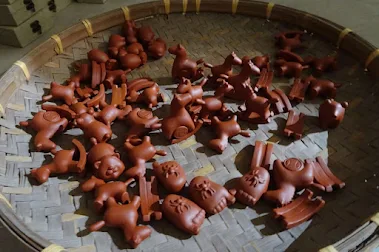Chaozhou is known for many things, but for tea lovers, it’s the home of Phoenix Dan Cong oolong and Gongfu-style brewing. Tucked into this tea-loving town is a quiet yet influential potter, Yujian Cai, who is shaping more than just clay—he’s shaping the future of how tea is brewed and appreciated.
Born in 1996 and raised in a family of ceramicists, Cai quite literally grew up playing with clay. His father and grandfather were both part of Chaozhou’s rich ceramic industry, and he spent his childhood in their studio, surrounded by mud, kilns, and tools. But it wasn’t until he turned 19 that he entered the world of hand-pulled teapots—a craft that would soon become his life’s calling.
Why Clay Matters in Chaozhou
For those unfamiliar, Chaozhou red clay is prized for its ability to bring out the best in oolong tea. The clay is slightly porous and retains heat beautifully, making it perfect for Gongfu-style brewing. This is especially important when working with Phoenix Dan Cong, a tea known for its layered floral and fruity aromas.
Unlike porcelain or ceramic gaiwans, which are more neutral, a red clay teapot made in Chaozhou adds warmth and texture to the brew. Over time, the clay absorbs tea oils and develops a natural patina—something connoisseurs love, as it deepens the flavor of future brews. Cai understands this relationship between clay and tea intimately. He recalls drinking Dan Cong with his elders from a very young age.
The Pear-Shaped Teapot
Cai’s signature form is the pear-shaped teapot, a design popularized during the Qing Dynasty and especially linked to the legendary potter Lu Si Ting. He began experimenting with this shape in 2018 and went all in by 2020. Since then, he has dedicated himself to refining it—not just for beauty, but for function.
The broad body of the pot holds heat well, while the narrow lid and elegant spout keep aroma locked in. It’s a shape that looks simple but requires immense skill to balance. Cai is even working on making the smallest functional pear-shaped teapot—his current goal is 50ml. “Any smaller and the spout won’t pour properly,” he says.
For him, it’s not about mass production. Every piece is shaped by hand, aligned precisely, and tested to pour perfectly. The result? A teapot that doesn’t just sit pretty—it works hard with your leaves.
Tea Pets and Playfulness
Beyond serious teaware, Cai also brings a bit of fun to the tea table. He makes tea pets—small clay figures that accompany Gongfu sessions and are “fed” tea over time. These aren’t just decorative. As they absorb tea, they develop a shine and become part of the brewing ritual.
One of his most unique creations is a small cow with a dent in its head—meant to rest your thumb. It acts like a calming fidget object and a tea companion all in one. This blend of tradition and modern mindfulness is what makes Cai’s work stand out.
Keeping Tradition Alive
Cai’s studio isn’t just a place for making pots—it’s a space where tradition is preserved and passed on. He collects antique teaware, studies Qing-era designs, and trains young apprentices to carry the craft forward. His love for Chaozhou's tea heritage is reflected in every pot, pet, and pour.
In a world where speed and scale often take over, Cai’s quiet commitment to detail feels refreshing. His work is a reminder that tea is more than just a drink. It’s an experience, a memory, and a ritual.
If you ever find yourself brewing a floral Dan Cong in a little red clay pot, take a moment to notice how it feels in your hand. Chances are, someone like Cai made it with intention, tradition, and a lot of love for tea.





Comments
Post a Comment